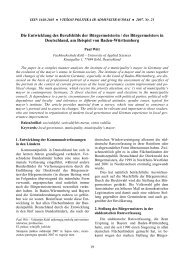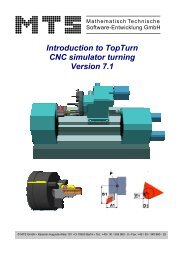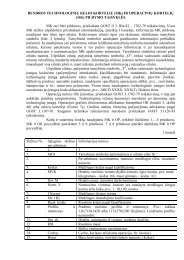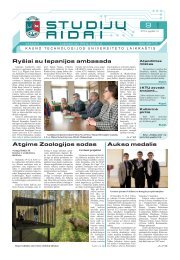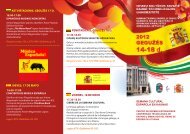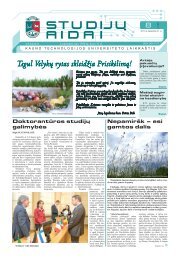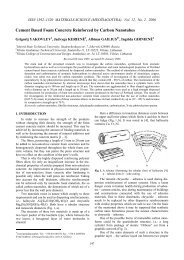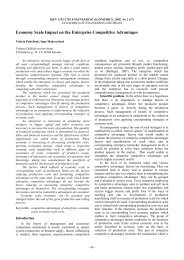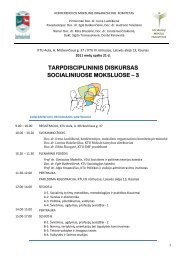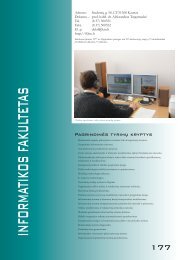Technical and classic yarns friction properties investigation
Technical and classic yarns friction properties investigation
Technical and classic yarns friction properties investigation
You also want an ePaper? Increase the reach of your titles
YUMPU automatically turns print PDFs into web optimized ePapers that Google loves.
54<br />
ISSN 1392 - 1207. MECHANIKA. 2006. Nr.4(60)<br />
<strong>Technical</strong> <strong>and</strong> <strong>classic</strong>al <strong>yarns</strong> <strong>friction</strong> <strong>properties</strong> <strong>investigation</strong><br />
V. Svetnickienė, R. Čiukas<br />
Kaunas University of Technology, Studentų 56, 51424 Kaunas, Lithuania, E-mail: ricardas.ciukas@ktu.lt<br />
1. Introduction<br />
Friction is very important characteristic of textile<br />
materials. Through the <strong>friction</strong> fibres are connected into<br />
<strong>yarns</strong> <strong>and</strong> the <strong>yarns</strong> into fabric or knitting. Some of the<br />
characteristics of textile products, such as touch <strong>and</strong> felt<br />
<strong>properties</strong>, softness etc., depend on <strong>friction</strong> [1].<br />
In technological processes of textile industry<br />
<strong>yarns</strong> or fabrics are moving not only on working surfaces,<br />
but also in respect of each other. All these facts have a big<br />
influence on weaving <strong>and</strong> especially knitting technological<br />
processes (for example, when making loops in knitting<br />
machinery etc.). Interaction between the <strong>yarns</strong>, based on<br />
<strong>friction</strong>, determines different mechanical <strong>properties</strong> of the<br />
woven <strong>and</strong> tricot fabrics, such as: traction, compression,<br />
twisting <strong>and</strong> shear characteristics [1-3]. The <strong>friction</strong> is directly<br />
influencing productivity <strong>and</strong> quality of textile production.<br />
This is very important reason for the <strong>investigation</strong><br />
of <strong>friction</strong> <strong>properties</strong>.<br />
In reprocessing of the yarn, it is frequently moving<br />
on metal, ceramic <strong>and</strong> other surfaces, so between the<br />
yarn <strong>and</strong> working surfaces there are <strong>friction</strong> forces. For<br />
that reason many experiments, investigating <strong>friction</strong> between<br />
a yarn <strong>and</strong> metal, ceramics or glass surfaces are performed<br />
by the method of <strong>friction</strong> cylinder. But it is necessary<br />
to remark, that a yarn can interact with parallel or perpendicular<br />
yarn. Not many experiments about the <strong>friction</strong><br />
between the <strong>yarns</strong> are performed. The majority of experiments<br />
are performed on the <strong>friction</strong> between single fibres,<br />
sliding in respect of each other [4-7]. Friction experiments<br />
with the new types of <strong>yarns</strong>, from metaaramid <strong>and</strong><br />
paraaramid fibres are also missing.<br />
Many different factors influence the yarn <strong>friction</strong>.<br />
Yarn tension force is the main factor, which influence all<br />
dynamic <strong>friction</strong> characteristics. The <strong>friction</strong> also depends<br />
on <strong>friction</strong> body bending angle, <strong>friction</strong> solid sleekness <strong>and</strong><br />
temperature, on twist of the exploratory yarn, surface<br />
greasiness, moving speed, yarn roughness, downiness,<br />
electrify <strong>properties</strong> etc. [1, 4, 5, 8, 9]. The influence of all<br />
these factors was almost not investigated for the <strong>yarns</strong>,<br />
designed for technical protective textile materials. The<br />
objective of this work is to investigate <strong>and</strong> compare <strong>friction</strong><br />
<strong>properties</strong> of technical <strong>and</strong> <strong>classic</strong>al <strong>yarns</strong>, used for the<br />
protective knitting, when the yarn is moving on nonmoving<br />
cylinder, needle, rotating disc in parallel <strong>and</strong> perpendicular<br />
yarn directions.<br />
2. Methods of <strong>investigation</strong><br />
The majority of technical <strong>and</strong> <strong>classic</strong>al <strong>yarns</strong> are<br />
used for knitted protective products (protective gloves,<br />
head covers, military <strong>and</strong> police sweaters), so it is very<br />
important, if these <strong>yarns</strong> with specific <strong>properties</strong> can be<br />
processed in the knitting machinery, especially because of<br />
its <strong>friction</strong> <strong>properties</strong>. The experiments were performed<br />
with <strong>classic</strong>al cotton, polyacrylnitrilic (PAN), polyamide<br />
(PA6) <strong>and</strong> technical (high strength SVM <strong>and</strong> nonflammable<br />
Fenilon <strong>and</strong> Nomex ) <strong>yarns</strong>. The results of the<br />
yarn tension are shown in Table 1.<br />
The results of the yarn tension<br />
Table 1<br />
Yarn<br />
Linear density,<br />
tex<br />
Breaking force, N<br />
Elongation at<br />
break, %<br />
SVM 29.4 35.0 6.4<br />
Fenilon 14.3*2 10.1 28.0<br />
Nomex 18*2 8.9 5.4<br />
PA 6 6.8*2 6.2 27.2<br />
PAN 16.5 2.3 21.8<br />
Cotton 20*2 7.1 13.0<br />
The coefficient of <strong>friction</strong> was determined analysing<br />
the <strong>friction</strong> of a yarn <strong>and</strong> cylinder, needle <strong>and</strong> disc, <strong>and</strong><br />
using twisted yarn methods. Experiments were performed<br />
under normal conditions: air humidity 65±2 % <strong>and</strong> temperature<br />
20±2°C. Experiments were performed with constant<br />
speed of the yarn movement (0.15 m/s), when the<br />
experimented yarn is surrounding:<br />
1) nonmoving metal cylinder, with the diameter of<br />
10 mm;<br />
2) knitting needle, with the diameter of 1.5 mm;<br />
3) pulley, rotating in the ball bearing.<br />
In all the cases the dependence of <strong>friction</strong> coefficient<br />
on initial yarn tension force T1 was investigated. In<br />
order to avoid the influence of the yarn unb<strong>and</strong>age from<br />
the bobbin, the branch was tensed with 3 weights of different<br />
mass causing the yarn tension force of 10, 20, 30 cN.<br />
The experiment was performed on a st<strong>and</strong>, which scheme<br />
is shown in Fig. 1.<br />
Mass M gives the input tension force T1 for yarn<br />
S, which is wrapped on the <strong>friction</strong> body V. The output<br />
Fig. 1 Scheme of yarn <strong>friction</strong> measurement device tension<br />
T2 is measured by sensor J.<br />
When the yarn is moving on a metal cylinder,<br />
knitting needle or the disc, rotating in a ball bearing or
when the <strong>yarns</strong> slide in respect of each other, tension force<br />
T2 in the running-off part of yarn was measured with electronic<br />
tensiometer sensor ELTENS FY-23. It was rejected<br />
to measure tension force of the running-on part of the<br />
yarn, because constant weight was connected to this part of<br />
yarn, so there was no tension force oscillations, caused by<br />
the balloon, bobbin conicality, fibres adhesion. The <strong>friction</strong><br />
force was measured in 3 ways.<br />
2.1. Friction measurement, when the yarn is wrapped on<br />
non moving cylinder<br />
When the yarn parts are parallel (Fig. 2, a), the<br />
coefficient of <strong>friction</strong> is calculated using Oiler formula<br />
μπ<br />
T2 = T1e<br />
(1)<br />
μ = T / T /<br />
(2)<br />
( ) π<br />
ln 2 1<br />
where μ is coefficient of <strong>friction</strong>; T2 is yarn tension force<br />
us the running-off part; T1 is yarn tension force us the running-on<br />
part.<br />
It was performed for 3 cases (Fig. 2).<br />
a b c<br />
Fig. 2 Friction measurement, when the yarn is sliding on a<br />
nonmoving cylinder: a - yarn branches are parallel,<br />
<strong>friction</strong> angle π; b - running-off part of yarn is<br />
wrapped one time around the running-on part of part<br />
of yarn; c - running-off part of yarn is wrappe two<br />
times around the running-on part of yarn<br />
When the yarn branches are twisted in respect of<br />
each other (Fig. 2, a, c), the coefficient of <strong>friction</strong> is recommended<br />
to calculate by J. Lindberg <strong>and</strong> N. Gralen formula<br />
[1, 4]<br />
( T / T ) / ( π β )<br />
μ = n<br />
(3)<br />
ln 2 1<br />
where β is the angle between twisted yarn branches; n is the<br />
number of twists in two twisted yarn branches.<br />
It is difficult to evaluate the term π⋅ n ⋅ β precisely,<br />
because in the experiment this angle varies, if the yarn <strong>friction</strong><br />
<strong>and</strong> rigidity are different. In the experiments where<br />
yarn str<strong>and</strong>s are bonded only <strong>friction</strong> resistance (left product<br />
in formula (4) was determined<br />
( πn<br />
β ) = ln(<br />
T2<br />
/ T1<br />
)<br />
μ (4)<br />
55<br />
2.2. Coefficient of <strong>friction</strong> measurement, when the yarn is<br />
sliding on knitting needle<br />
a b c<br />
Fig. 3 Yarn position during <strong>friction</strong> experiments in knitting<br />
needle, when the yarn is wrapping the needle by angle<br />
π <strong>and</strong> when using twisted yarn method<br />
The cases a, b, c (Fig. 3) are the same, as mentioned<br />
before, but instead of nonmoving cylinder the yarn<br />
is moving on nonmoving needle.<br />
2.3. Friction measurement, when the moving yarn is turning<br />
freely rotating disc<br />
a b c<br />
Fig. 4 Yarn position, when the yarn is moving on the surface<br />
of rotating in the ball bearings pulley <strong>and</strong> the<br />
yarn is wrapping it by angle π (a) <strong>and</strong> by twisted<br />
yarn method (b <strong>and</strong> c)<br />
The method of J. Lindberg <strong>and</strong> N. Gralen is dedicated<br />
to measure <strong>friction</strong> between <strong>yarns</strong>. The basis of this<br />
method is the difference of tension forces between two<br />
twisted <strong>yarns</strong>, one of which is tensed. The <strong>friction</strong> is investigated<br />
using this method, when running-off part of the<br />
yarn is wrapping running-on part of the yarn one or two<br />
times. Both <strong>yarns</strong> are sliding in respect of each other.<br />
The principle of this method: when the tensioned<br />
yarn is moving with certain speed, it is surrounding the
pulley, rotating in the ball bearing (Fig. 4, a). The runningoff<br />
part of the yarn is wrapping the running-on part of the<br />
yarn one (Fig. 4, b) <strong>and</strong> two times (Fig. 4, c). Tension<br />
forces of the running-off part of yarn T2 are measured, the<br />
<strong>friction</strong> resistance, using J.Linberg <strong>and</strong> N.Gralen formula<br />
(4) is calculated.<br />
The variant a did not give any result, because the<br />
<strong>friction</strong> force was insignificant in all cases.<br />
3. Investigation results<br />
In knitting process the yarn tension force varies<br />
until 10 cN, though in different points of loop formation it<br />
supposedly can change no more than three times, therefore<br />
<strong>friction</strong> experiments were performed when the tension<br />
force of the running-on part of yarn was 10, 20, 30 cN.<br />
The scatter of results was checked for technical<br />
<strong>yarns</strong>.<br />
Variation coefficients of the experiments<br />
T1, cN<br />
SVM<br />
v, %<br />
Fenilon Nomex<br />
10 5.4 4.8 8.3<br />
20 4.1 9.4 4.9<br />
30 6.6 6.2 5.3<br />
Table 2<br />
The Table 2 shows, that the scatter of measurement<br />
results does not exceed 10 % <strong>and</strong> it is possible to<br />
assume, that the experiments were performed with ade-<br />
quate precision.<br />
For all <strong>yarns</strong>, when they were parallel <strong>and</strong> were<br />
sliding on nonmoving metal cylinder <strong>and</strong> nonmoving needle,<br />
the coefficient of <strong>friction</strong> was calculated <strong>and</strong> shown in<br />
Table 3.<br />
Results of <strong>friction</strong> coefficient analysis show that<br />
by increasing the tension force of the yarn the coefficient<br />
56<br />
Table 3<br />
Coefficient of <strong>friction</strong> when yarn branches are paralleled<br />
<strong>and</strong> they are sliding on nonmoving cylinder (Fig. 2, a) <strong>and</strong><br />
on knitting needle (Fig. 3, a)<br />
Yarn Cylinder Needle<br />
T1, cN T1, cN<br />
10 20 30 10 20 30<br />
SVM 0.42 0.32 0.32 0.33 0.22 0.15<br />
Fenilon 0.36 0.28 0.25 0.31 0.23 0.19<br />
Nomex 0.35 0.24 0.23 0.15 0.11 0.10<br />
PA 6 0.41 0.35 0.34 0.34 0.28 0.22<br />
PAN 0.37 0.30 0.27 0.24 0.18 0.11<br />
Cotton 0.36 0.33 0.30 0.17 0.15 0.14<br />
of <strong>friction</strong> decreases for all <strong>yarns</strong>, though its values are<br />
lower for technical SVM, Fenilon <strong>and</strong> Nomex <strong>yarns</strong>. The<br />
decrease of coefficient of <strong>friction</strong> is higher for technical<br />
yarn.<br />
The decrease of <strong>friction</strong> coefficient can be explained<br />
as the investigated <strong>yarns</strong> have the rigidity, which is<br />
not evaluated in the Eq. (1).<br />
The decrease of <strong>friction</strong> force when threads are<br />
sliding on knitting needle may be explained according the<br />
Eq. (5), which shows [6], that tension force T2 will be<br />
lower when radius R is declined<br />
R<br />
μ ⋅α<br />
R+<br />
r<br />
T2 = T1e<br />
(5)<br />
where R is radius of <strong>friction</strong> body; r is radius of the yarn.<br />
For other variants of experiments only <strong>friction</strong> resistance<br />
(the product of coefficient of <strong>friction</strong> <strong>and</strong> angle) is<br />
shown, because the angle of str<strong>and</strong>s crossing was inconstant<br />
in different experiments <strong>and</strong> for different <strong>yarns</strong>. Results<br />
are shown in Tables 4-6.<br />
Results of <strong>friction</strong> experiments, when the yarn was moving on a cylinder<br />
1a 1b 1c<br />
Yarn<br />
T1, cN T1, cN T1, cN<br />
10 20 30 10 20 30 10 20 30<br />
SVM 1.31 1.01 0.92 1.36 1.13 0.97 1.46 1.25 0.99<br />
Fenilon 1.13 0.88 0.79 1.34 1.03 1.04 1.53 1.41 1.32<br />
Nomex 1.10 0.74 0.72 1.25 0.88 0.76 1.46 1.05 0.87<br />
PA 6 1.28 1.11 1.07 1.39 1.27 1.17 1.61 1.48 1.29<br />
PAN 1.16 0.93 0.85 1.34 1.10 0.94 1.46 1.19 0.97<br />
Cotton 1.12 1.05 0.93 1.41 1.22 0.99 1.63 1.37 1.19<br />
Results of <strong>friction</strong> experiments, when the yarn was moving on a needle<br />
2a 2b 2c<br />
Yarn<br />
T1, cN T1, cN T1, cN<br />
10 20 30 10 20 30 10 20 30<br />
SVM 1.03 0.68 0.47 1.16 0.77 0.61 1.25 0.92 0.80<br />
Fenilon 0.99 0.72 0.59 1.19 0.92 0.63 1.36 1.03 0.72<br />
Nomex 0.47 0.34 0.31 0.74 0.53 0.47 0.88 0.72 0.68<br />
PA 6 1.07 0.88 0.69 1.19 1.01 0.80 1.39 1.15 0.92<br />
PAN 0.76 0.56 0.36 0.89 0.76 0.54 0.99 0.90 0.79<br />
Cotton 0.53 0.48 0.43 0.69 0.62 0.53 1.07 0.83 0.61<br />
Table 4<br />
Table 5
4. Conclusions<br />
57<br />
Results of <strong>friction</strong> experiments, when the yarn was moving on rotating pulley<br />
3b 3c<br />
Yarn<br />
T1, cN T1, cN<br />
10 20 30 10 20 30<br />
SVM 0.69 0.30 0.21 0.83 0.50 0.42<br />
Fenilon 0.69 0.37 0.28 1.03 0.53 0.42<br />
Nomex 0.59 0.30 0.18 0.88 0.50 0.36<br />
PA 6 0.74 0.44 0.38 0.99 0.74 0.45<br />
PAN 0.59 0.30 0.26 0.92 0.50 0.36<br />
Cotton 0.74 0.47 0.29 1.16 0.77 0.43<br />
The received results for all <strong>yarns</strong> by all methods<br />
show that the increase of <strong>yarns</strong> tension force decreases<br />
<strong>friction</strong> force. When the yarn is moving through the needle,<br />
the <strong>friction</strong> resistance is lower, than when the yarn is sliding<br />
on a cylinder.<br />
Friction resistance of twisted <strong>yarns</strong> is increasing<br />
when revolution frequency increases. Friction resistance of<br />
the yarn is the highest while they are sliding on a nonmoving<br />
cylinder, lower – while moving through the needle.<br />
Friction resistance of the <strong>yarns</strong>, twisted into one str<strong>and</strong> <strong>and</strong><br />
moving on rotating disc is two times lower than if they<br />
were sliding on a cylinder surface.<br />
SVM <strong>and</strong> Fenilon <strong>yarns</strong> are characterized with<br />
higher <strong>friction</strong>, Nomex – with lower <strong>friction</strong>. While investigating<br />
twisted <strong>yarns</strong> there was noticed, that the running<br />
on yarn branch with tension force T1 is straight. Friction<br />
resistance of the polyamide, polyacrylnitrilic <strong>and</strong> cotton<br />
<strong>yarns</strong> is changing much less. Friction resistance of the last<br />
mentioned is higher in all cases. After comparison of the<br />
determined coefficients of <strong>friction</strong> it is possible to state,<br />
that all of the investigated <strong>yarns</strong> can be processed in knitting<br />
machinery; because the coefficients of <strong>friction</strong> of<br />
technical <strong>and</strong> <strong>classic</strong>al <strong>yarns</strong>, determined by needle <strong>and</strong><br />
cylinder methods, are from the same ranking, but technical<br />
<strong>yarns</strong> have slightly lower <strong>friction</strong>. In knitting process it<br />
would be possible to keep the same SVM tension force as<br />
polyamide PA, Fenilon as PAN <strong>and</strong> SVM as cotton <strong>yarns</strong>.<br />
Some problems may be with SVM threads, because<br />
they are very stiff <strong>and</strong> do not fit for knits, because<br />
<strong>friction</strong> is the reason of tension rising during knitting.<br />
References<br />
1. Matukonis, A., Palaima, J., Vitkauskas, A. Material<br />
cience of Textile.- Vilnius: Mokslas, 1976.-424p. (in<br />
Lithuanian).<br />
2. Sebastian, SARD, Balley, A. J., Brisco, B. J., Tabor,<br />
D. Extensions, displacements <strong>and</strong> forces associated<br />
with pulling a single yarn from a fabric.- Pr., J. Appl<br />
Phys, 1987, No10, p.130-139.<br />
3. Matukonis, A., Kauzoniene, S., Gajauskaite, J. Frictional<br />
Interaction Between Textile Yarns.- Materials<br />
Science, 1999, No4, p. 50-52.<br />
4. Morton, W. E., Hearle, J. W. Physical <strong>properties</strong> of<br />
textile fibres.- The Textile Institute, 1962, p.559-590<br />
5. Varža, V. Manufacturing of Wool-Polyester Yarns,<br />
Having Different Structure <strong>and</strong> Investigation of Them<br />
Properties.- PhD thesis.- Kaunas, 1981.-149p. (in Russian).<br />
Table 6<br />
6. Sevostjanov, A.G., Sevostjanov, P.A. Simulation of<br />
Technology Processes.- Moscow, 1984.-344p. (in Russian).<br />
7. Denby, E.F., Andrews, M.W. Friction forces on wool<br />
fibers in a worsted fabric.- Textile Research J., 1965,<br />
No10, p.913-922.<br />
8. Wegener, W., Shuler, B. Determination of the <strong>friction</strong><br />
coefficient.- Textilindustrie, 1964, No6, p.458-463 (in<br />
Deutsch).<br />
9. Pažarauskas, E. Prediction of Friction Properties of<br />
New Threads According up Today Technologies.- PhD<br />
thesis.- Kaunas, 1992.-191p. (in Russian).<br />
V. Svetnickienė, R. Čiukas<br />
TECHNINIŲ IR KLASIKINIŲ SIŪLŲ TRINTIES<br />
SAVYBIŲ TYRIMAS<br />
R e z i u m ė<br />
Straipsnyje pateikiami techninių ir klasikinių siūlų,<br />
naudojamų techninei apsauginei tekstilei, trinties tyrimo<br />
rezultatai. Kadangi tirti siūlai gali būti naudojami megztoms<br />
pirštinėms, kaukėms, kad neapdegtų kūnas, tai labai<br />
svarbu žinoti, ar šie siūlai, pasižymintys specifinėmis savybėmis,<br />
gali būti perdirbami mezgimo mašinomis, ypač dėl<br />
savo trinties savybių.<br />
Tyrimui buvo naudojami techniniai (SVM, Fenilon,<br />
Nomex) ir klasikiniai (medvilniniai, PA6, PAN) siūlai. Trinties<br />
koeficientas buvo nustatomas trinties velenėlio ir susuktų<br />
siūlų metodais. B<strong>and</strong>ymai buvo atliekami esant pastoviam<br />
siūlo judėjimo greičiui, kai b<strong>and</strong>omasis siūlas juda nejudamu<br />
velenėliu, mezgimo adata, besisukančiu diskeliu<br />
lygiagrečiomis bei sukryžiuotomis siūlų vijomis, keičiant<br />
siūlo įtempį.<br />
Tyrimai parodė, kad visi tirti siūlai gali būti perdirbami<br />
mezgimo mašinomis, nes tiek techninių, tiek klasikinių<br />
siūlų trinties koeficientai, nustatyti velenėlio ir adatos<br />
metodais, yra tos pačios eilės, tačiau perdirbant SVM<br />
siūlus, kurie yra labai st<strong>and</strong>ūs, įtempį reikia sumažinti.<br />
V. Svetnickienė, R. Čiukas<br />
TECHNICAL AND CLASSICAL YARNS FRICTION<br />
PROPERTIES INVESTIGATION<br />
S u m m a r y<br />
Investigation results of the technical <strong>and</strong> <strong>classic</strong>al<br />
<strong>yarns</strong>, which are used for technical protective textiles are
presented in the article. Since the investigated <strong>yarns</strong> can be<br />
used in production of knitted gloves, masks for the body<br />
protection from fire, it is very important, if these <strong>yarns</strong>,<br />
having specific characteristics, can be processed in production<br />
with knitting machinery, especially due to their <strong>friction</strong><br />
<strong>properties</strong>.<br />
For the <strong>investigation</strong> technical – SVM, Fenilon,<br />
Nomex <strong>and</strong> classsical – Cotton, PA6, PAN <strong>yarns</strong> were<br />
used. The coefficient of <strong>friction</strong> was determined by using a<br />
<strong>friction</strong> cylinder <strong>and</strong> twisted yarn methods. The<br />
experiments were performed with the constant moving<br />
speed of a yarn, when examined yarn is moving on a nonmoving<br />
cylinder, needle, rotating disc in parallel <strong>and</strong> crossing<br />
yarn str<strong>and</strong>s, changing tension of the <strong>yarns</strong>.<br />
Experiments showed, that all the investigated<br />
<strong>yarns</strong> can be processed in knitting machinery, because the<br />
coefficients of <strong>friction</strong> of technical <strong>yarns</strong>, as well as the<br />
<strong>classic</strong>al <strong>yarns</strong>, determined by cylinder <strong>and</strong> needle methods,<br />
are in the same range, but for the SVM <strong>yarns</strong> the<br />
tension must be lower,because they are very stiff.<br />
58<br />
В. Светницкиене, Р. Чюкас<br />
ИССЛЕДОВАНИЕ СВОЙСТВ ТРЕНИЯ<br />
ТЕХНИЧЕСКИХ И КЛАССИЧЕСКИХ НИТЕЙ<br />
Р е з ю м е<br />
В статье представлены результаты исследования<br />
коэффициента трения технических и классических<br />
нитей, изпользуемых для производства технического<br />
текстиля. Поскольку исследуемые нити могyт быть<br />
изпользованы для производства огнезащитных перчаток<br />
и масок, необходимо знать, что данная пряжа, отличающаяся<br />
специфическими свойствами, может быть<br />
переработана на вязальных машинах, особенно из-за<br />
своих свойств трения.<br />
В исследовании была использована техническая<br />
(SVM, Fenilon, Nomex) и классическая<br />
(xлопковая, PA6, PAN) пряжа. Коэффициент трения был<br />
определен по методу валика трения и методу скрученной<br />
пряжи. Изследовалась зависимость трения от начального<br />
натяжения пряжи при постоянной скорости движения<br />
пряжи, когда пряжа движится по неподвижному валику,<br />
игле, вращающемуся диску, с параллельной и перекрестной<br />
намоткой пряжи.<br />
Иcследования показали, что вся иcследованная<br />
пряжа может перерабатыватся на вязальных машинах,<br />
поскольку коэффициенты трения и технической, и<br />
классической пряжи, установленные методами валика<br />
и иглы, являются того же ряда, но для нитей SVM необходимо<br />
уменшить натяжение нити при переработке,<br />
тaк кaк они очень жесткие.<br />
Received December 22, 2005



